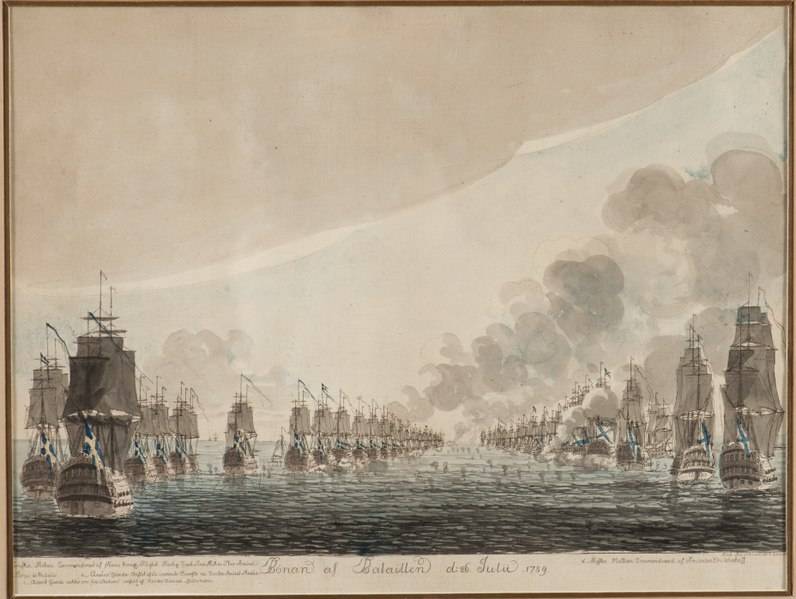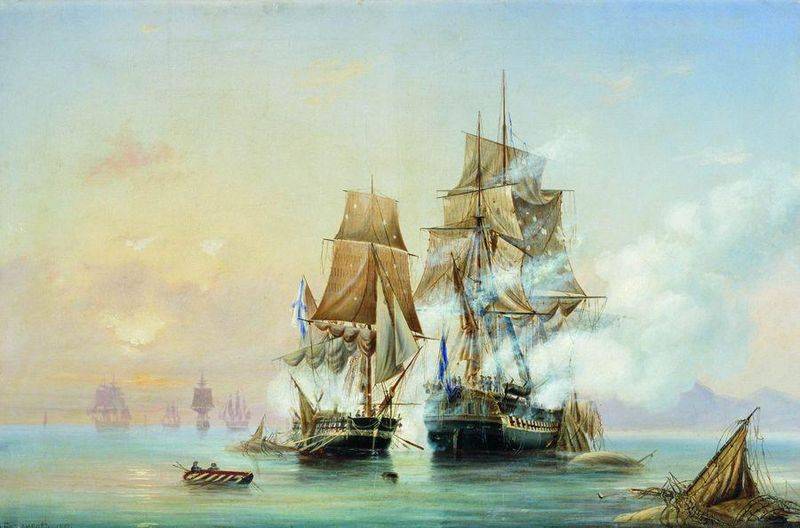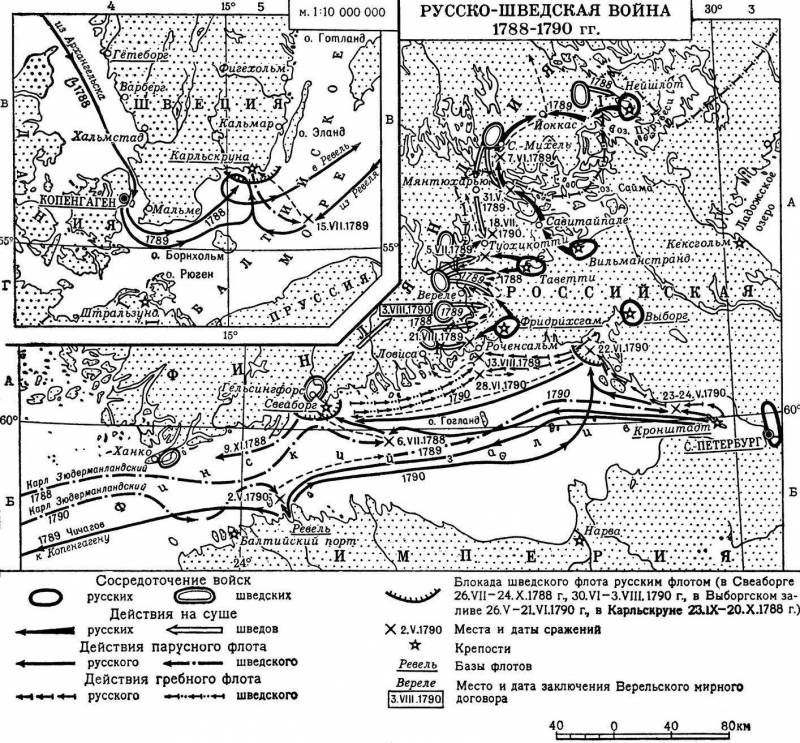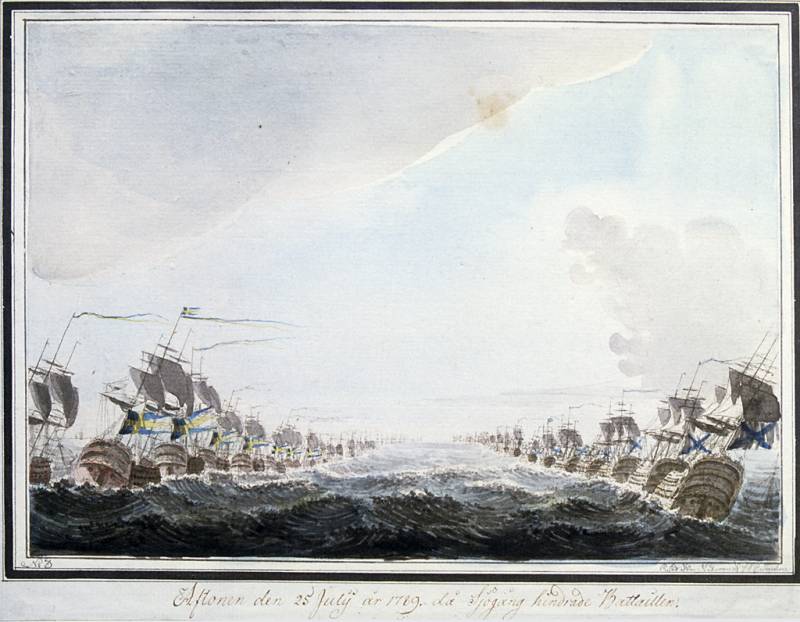Åland Sea Battle

General situation
Sweden, pushed by England, France and Prussia, decided to restore its former dominance in the Baltic, and in 1788, it began a war with Russia. The Swedish king Gustav III hoped that the main and best forces of Russia were tied with the war with the Turkish Empire. The Swedish leadership was hoping for a surprise attack on land and at sea to threaten the seizure of the Russian capital, St. Petersburg, and force Catherine II to agree to a world advantageous to Sweden.
In July, 1788, 38-thousand. the Swedish army led by the king moved to Friedrichsgam, Wilmanstrand and Nyslott. Russian 14-thousand The army led by Count Musin-Pushkin was extremely weak, mainly consisting of barely trained or not trained soldiers at all. However, the Swedes could not use their numerical and qualitative advantage, stuck in an unsuccessful siege of Nashloth. In August, the Swedish army retreated beyond its borders, empty-handed. The Swedish fleet under the command of the brother of the king, the duke Charles Südermanland, was to attack the Russian fleet at Kronstadt and land troops to attack the Russian capital. A squadron led by Admiral Greig left Kronstadt and, as a result of the Gogland battle, 6 (17) in July forced the Swedish fleet to retreat to Sveaborg. There the Swedes blocked our fleet.
During the blockade of the Swedish fortress, Admiral Greig became seriously ill. October 15 Samuel Greig died. In his absence, command of the fleet was received by Rear Admiral Kozlyanin. He removed the blockade of Sveaborg and the Russian fleet went to spend the winter in Revel and Kronstadt. On November 9, the Swedish ship fleet left Sveaborg and calmly reached its main naval base, Karlskrona. The Swedish king was able to return to Sweden with his loyal troops and put down the insurgency.
Thus, the plan of the "Swedish Blitzkrieg" was destroyed. Stockholm was unable to exploit Russia's weakness in the St. Petersburg direction. Denmark entered the war against Sweden, there was a threat of invasion of its troops. In addition, a rebellion began in Sweden itself. Anyalsky Union (a group of officers-rebels) opposed the absolutism of King Gustav III. The rebels presented to the king demands to end the war, convene the Riksdag (Swedish rule) and restore the constitutional order. The rebellion was suppressed, but Stockholm distracted from the war with Russia.
Copenhagen squadron
The main events took place at sea. The outcome of the war depended on the outcome of the confrontation between the Russian and Swedish fleets. The Swedes hoped to crush the Russian fleet, divided into two large parts (in Copenhagen and Kronstadt), and thereby force St. Petersburg to a world advantageous to Sweden. Even before the start of the war in 1788, part of the Baltic Fleet was sent to the Mediterranean to fight the Turks. The squadron consisted of three new 100-gun ships “John the Baptist” (“Chesma”), “Three Hierarchs” and “Saratov”, 32-gun frigate “Nadezhda”, as well as several transports. The detachment was commanded by Vice Admiral Willim Petrovich Fondesin (von Desin). In Copenhagen, the Mercury and Dolphin boats built in England joined the fondesin squadron. In addition, a squadron of Rear Admiral Povalishin came to the Danish capital - four new ships built in Arkhangelsk, two frigates. Denmark, which was an ally of Russia, strengthened the Russian squadron with three battleships and one frigate. As a result, a strong squadron appeared in Russia - 10 battleships, 4 frigate, 2 boats, several transports.
The commander of the Copenhagen squadron, Fondazin, was a weak naval commander. At the beginning of the war, he received the task of attacking the Swedish port of Gothenburg, where there were three enemy frigates, then it was possible to attack the Swedish city of Mästrand. But the admiral was inactive. Then, Fondezin, having no information about the enemy, sent two vehicles to Arkhangelsk with artillery and other equipment for new ships. The Swedes captured the Kildin transport in full view of the Russian fleet.
Further, Fondezin was ordered to block Karlskrona and, upon the appearance of an enemy fleet, give him battle. In September - October 1788, our squadron went to blockade the Swedish port. But having learned about the death of Admiral Greig and about the withdrawal of Kozlyaninov's squadron, who blocked the Swedish ships in Sveaborg, Fadezin was afraid of meeting with the enemy fleet and retreating to Copenhagen. He did not even wait for the three ships that Kozlyanins sent him. Thanks to this, the Swedish fleet calmly came to Karlskrona.
On November 12, three ships from Revel (Panteleimon, Victorious, and Mecheslav) arrived in Copenhagen, joining Fondezin's squadron. The admiral nearly killed them. Having spent a whole month setting up ships for a safe wintering, Fondezin left them in Sound (this is the strait separating Sweden from the Danish island of Zeeland). There the ships spent the whole winter, being threatened with death, rushed along with the ice between the shores of Denmark and Sweden. The ships did not die, which was the merit of their crews and happy accident. Not for nothing, Empress Catherine the Second noted: “Fondezin will sleep and lose ships”. At the end of December, he was replaced, and in the spring of 1789, Kozlyanin joined the command of the Copenhagen squadron, who was made vice-admiral.
1789 Campaign
In 1789, the Russian army in Finland was brought to 20 by a thousand people and Musin-Pushkin decided to go on the offensive, despite the numerical superiority of the enemy. The war was moved to Swedish territory. During the summer, our troops occupied a large part of Finland with S. Michel and Friedrichsgam. There were no major battles on land, as in the 1788 campaign of the year.
At sea, the opposition continued. By the beginning of the 1789 campaign of the year, the Russian fleet, reinforced by newly built rowing ships, had 35 battleships, 13 frigates and more 160 rowboats. The Russian fleet was divided into several parts: in Revel stood a squadron of Admiral Chichagov, who was appointed commander of the Baltic Fleet; a squadron of Rear Admiral Spiridov was being trained in Kronstadt and a reserve squadron of Vice Admiral Kruse was stationed; in Denmark - Kozlyaninov squadron; The rowing fleet was concentrated mainly in Petersburg. At the same time, the position of our ships in the Danish capital was complicated by the hostile attitude of England and Prussia. Copenhagen was under pressure from London and Berlin and was forced to stop the war with Sweden, although without peace. However, the Danes valued an alliance with Russia, so they considered it their duty to protect our squadron. The Danish fleet together with our ships defended the entrance to the Copenhagen raid. That is, the Danes defended their capital from the Swedes and at the same time supported the Russian squadron. By the summer, the naval artillery of the Russian squadron was noticeably strengthened by replacing the 6- and 12-pound cannons with the 24- and 36-pound carronades purchased from the British.
The Swedish ship fleet consisted of 30 battleships that were in Karlskrona. Three large frigates wintered in Gothenburg. The rowing fleet was divided into two parts: the first was located in Stockholm and other ports of Sweden, the second - in Sveaborg. Also several ships were on Lake Saimao. The Swedish command was going to prevent the Russians from joining forces, breaking up the Russian fleet in parts and gaining dominance at sea.
The fighting in 1789 began with the feat of the boat “Mercury” by Lieutenant Commander Roman Crone. In April, the 22-gun boat went from Copenhagen to cruise and took the Swedish merchant ships into the 29 prize, in May - attacked and captured the 12-gun tender “Snapapop”. May 21 (June 1) in the Christian Fjord "Mercury" discovered the Swedish 44-gun frigate "Venus". Crown showed not only courage, but also military trick. The boat was disguised as a merchant ship, and using calmness, came close to the stern of the enemy frigate. If there was a wind, the Swedish frigate could simply shoot the Mercury out of 24-pounder guns at a half-verst distance, without entering the zone of shelling of its small-caliber guns (he could conduct an effective firing at a quarter of a mile). The Russian ship rose to the stern of the frigate and opened fire on the rigging and spars of the enemy. The Swedes could only fire from utah (there were several 6-pounder guns), and during the hour and a half they lost most of the spars and rigging. The Swedish frigate surrendered, the 302 man was taken prisoner. Our casualties are 4 dead and 6 injured. For this battle, the Russian empress awarded Crown the Order of St. George of the 4 degree and produced him in the captains of the 2 rank. Brave was appointed commander of the captured frigate. During the war with Sweden, Crone distinguished himself in several battles, and was promoted to captain of the 1 rank. In 1824, he was promoted to the rank of full admiral.
In May, Chichagov sent ships to the entrance to the Gulf of Finland to observe the Swedish fleet and to the skerries of Gangut and Porkallaud to inspect these important points and attack the communications of the Swedish galley fleet. However, the Swedes used the fact that during the 1788 campaign, the Russians did not occupy Gangut and erected strong fortifications there, in the spring, armed with 50 guns and mortars. By this they secured free passage through the skerries.
Shipped from Revel to Porkalladu, captain of the 2 rank Sheshukov with a detachment of the Boleslav battleship, the frigates Premislav, Mstislavets and the Neva and the Flying boats found the Swedish ships that provided land ships troops. The Swedes tried to oust the Sheshukov detachment, but without success. 6 June The 21 ships of the Swedish rowing fleet, which left Sveaborg and wanted to break through in the area of Porkallaud, with the support of coastal batteries, attacked the Russian squadron. After a stubborn two-hour battle, the Swedes retreated. Russian ships landed troops and destroyed the enemy coastal battery. On June 8, the Sheshukov detachment at Porkallaud's position was replaced by a detachment of the captain of the 23 rank of Glebov (1 battleship, 2 frigate and 2 boats). Glebov's detachment remained in this position until mid-October.
In August, the Swedes again attempted to unlock Porkallaud. To this end, a detachment of the 3 battleships and 3 frigates left Karlskrona. Swedish ships approached Berezund, where they joined the rowing fleet and were about to attack the Glebov detachment. However, here the Swedes learned that a squadron of Trevenen came to the aid of Glebov's squadron and that the main forces of the Russian fleet were found in the sea in the Revel area. As a result, the Swedes abandoned the operation to free the passage in the Porkallaud area and returned to Karlskrona.

Öland Battle
2 July 1789, the Rechelsky squadron of Chichagov, reinforced by the ships of Spiridov who arrived in late May from Kronstadt, went out to sea to join the Copenhagen squadron. The Russian fleet consisted of 20 battleships (3 - 100-gun, 9 - 74-gun and 8 - 66-gun), 6 frigates, 2 bombing ships, 2 boats and auxiliary vessels. Admiral Chichagov held the flank on the 100-gun "Rostilava", Rear Admiral Spiridov - on the 100-gun "Twelve Apostles", Vice-Admiral Musin-Pushkin - on the 100-gun "Vladimir".
14 (25) July 1789 of the year at the southern tip of the island of Öland Chichagov's squadron discovered the Swedish fleet under the command of the Duke Karl Södermanland (in Russian tradition Karl Südermanland). The Swedish fleet had a battleship 21 (7 - 74-gun ships, 14 ships had 60 to 66 guns) and 8 heavy frigates (40-44 guns), which the Swedes also put into battle line. The Swedes had the advantage in forces. However, the Russian battleships had more powerful artillery and numerous crews. On the Swedish ships was a shortage of crews.
The battle began on July 15 (26), at 14 hours, approximately 50 nautical miles southeast of Åland. The fleet of the Swedes, who was in the wind, in the line of battle on the left tack, began to slowly descend to the squadron of Chichagov. When the wind changed, the Swedes corrected their line and tried to keep in touch with Karlskrona. The skirmish at long range of large-caliber guns continued until the evening (the Russian naval commander Ushakov called such cases a “lazy battle”). Both admirals clearly avoided a decisive battle. After the battle, the Swedish fleet took refuge in Karskron.
As a result, the losses on both sides were small. Half of our ships were slightly damaged, others were intact. Killed and injured - 210 people. One of the best Russian sailors, the commander of Mstislav, Grigory Mulovsky, who in 1787 became head of a detachment of four ships assigned to the first Russian round-the-world voyage, was killed (as a result, the Russian government abandoned its plan for a world tour for many years). The 66-gun ship “Fight” of the captain of 1-th rank D. Preston (15 dead and 98 injured) suffered the greatest losses. He had to be sent for repair to Kronstadt. At the same time, the ship suffered no longer from enemy shells, but from the rupture of three of its guns. The Swedish fleet apparently suffered about the same losses. Already during the battle, three ships were withdrawn by tugs over the battle line.
Having learned from the merchants about the Battle of Eland, the Copenhagen squadron of Kozlyaninov left the Danish straits and soon joined the Chichagov fleet. For several days the Russian fleet held out at Karlskrona, and then returned to Revel. The Swedes did not dare to a new battle.
Thus, the Ezelsky battle tactically ended in a draw. However, strategically it was a Russian victory. Russian ship squadrons joined and gained dominance at sea.


Information